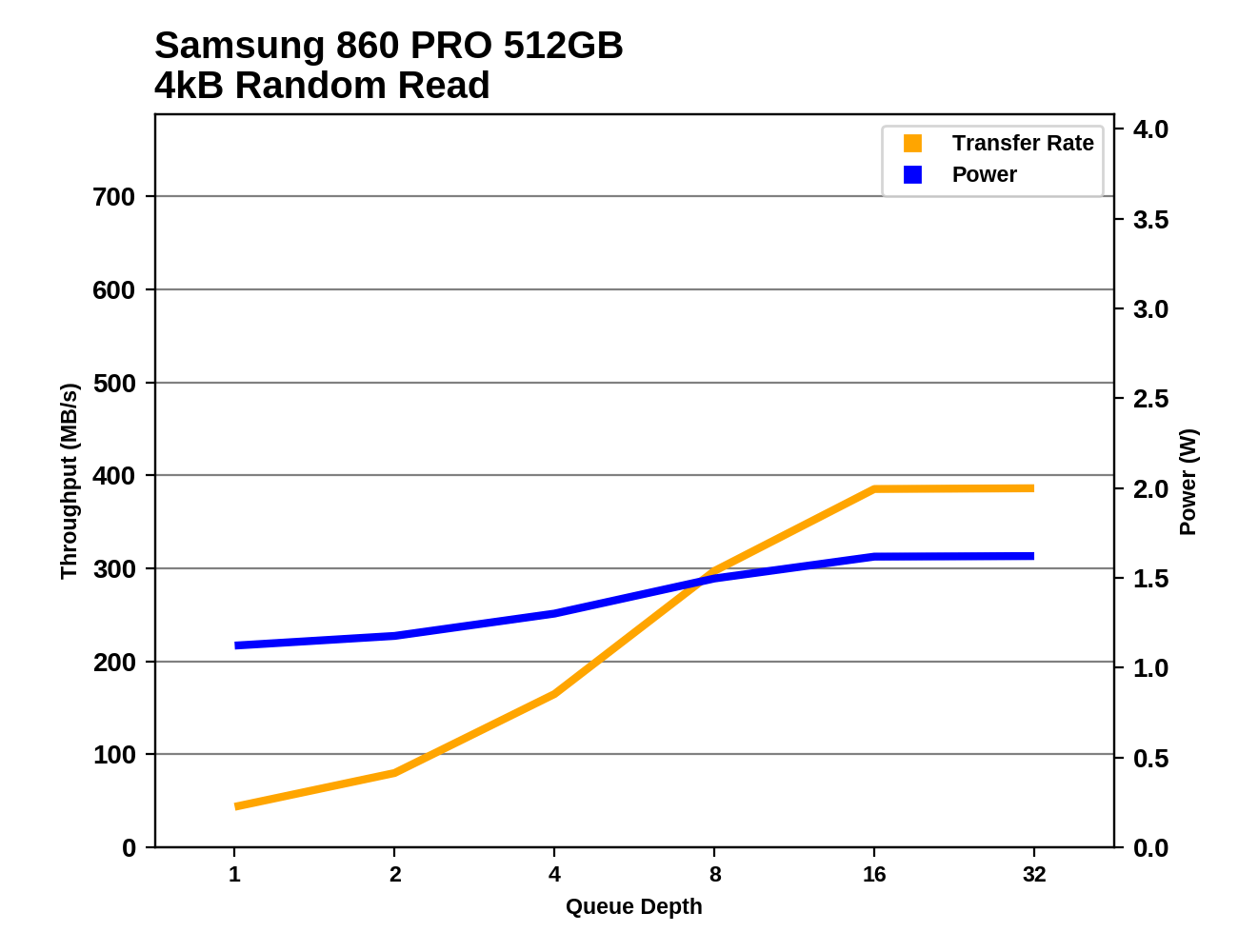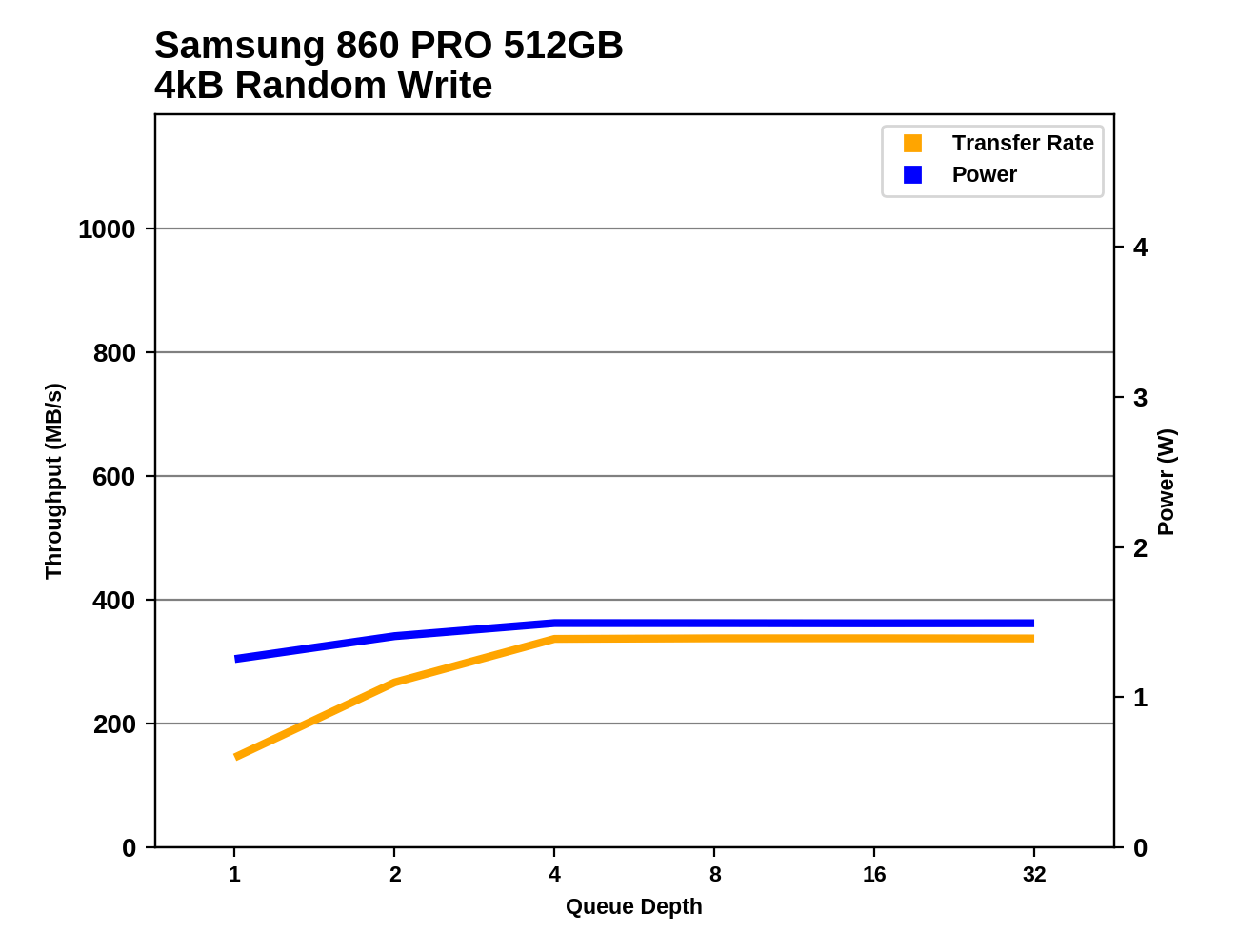The Samsung 860 PRO (512GB And 4TB) SSD Review: Replacing A Legend
by Billy Tallis on January 23, 2018 10:00 AM ESTRandom Read Performance
Our first test of random read performance uses very short bursts of operations issued one at a time with no queuing. The drives are given enough idle time between bursts to yield an overall duty cycle of 20%, so thermal throttling is impossible. Each burst consists of a total of 32MB of 4kB random reads, from a 16GB span of the disk. The total data read is 1GB.

The 512GB Samsung 860 PRO has the fastest burst random read speed among these SATA SSDs, about 5% faster than the 850 PRO. The 4TB model is the same speed as the 4TB 850 EVO.
Our sustained random read performance is similar to the random read test from our 2015 test suite: queue depths from 1 to 32 are tested, and the average performance and power efficiency across QD1, QD2 and QD4 are reported as the primary scores. Each queue depth is tested for one minute or 32GB of data transferred, whichever is shorter. After each queue depth is tested, the drive is given up to one minute to cool off so that the higher queue depths are unlikely to be affected by accumulated heat build-up. The individual read operations are again 4kB, and cover a 64GB span of the drive.

On the longer random read test involving some higher queue depths, the Samsung 860 PROs take a clear lead, and the 4TB model even outperforms the PM981 NVMe SSD.

The two Samsung 860 PROs offer the same power efficiency, which is a huge step up from the 850 PRO's efficiency and significantly better than any of the competition.
 |
|||||||||
Most of the Samsung drives hit the same limit of almost 400 MB/s around QD16. The two latest Crucial SSDs only just reach reach that level of performance at QD32, while the Intel 545s and Crucial MX300 never scale up that far. The PM981 NVMe drive scales far beyond any of the SATA drives, but at the cost of very poor power efficiency, especially at lower queue depths.
Random Write Performance
Our test of random write burst performance is structured similarly to the random read burst test, but each burst is only 4MB and the total test length is 128MB. The 4kB random write operations are distributed over a 16GB span of the drive, and the operations are issued one at a time with no queuing.

The 4TB 860 PRO has the fastest burst random write speed, while the 512GB model scores slightly worse than the 512GB 850 PRO.
As with the sustained random read test, our sustained 4kB random write test runs for up to one minute or 32GB per queue depth, covering a 64GB span of the drive and giving the drive up to 1 minute of idle time between queue depths to allow for write caches to be flushed and for the drive to cool down.

The sustained random write performance of the Samsung 860 PRO is a very slight improvement over their previous drives. Most of the competition is significantly slower on this test, but the Crucial BX300 is pretty close.

The Samsung 860 PROs are again the two most efficient SATA SSDs, and the 512GB model manages to match the efficiency of the much faster but more power hungry PM981.
 |
|||||||||
The 860 PRO reaches full random write speed at QD4 and is steady through the rest of the test. The Crucial MX500 and Intel 545s are much slower to get up to speed, and the SanDisk Ultra 3D plateaus at a mere 200MB/s after QD2.










64 Comments
View All Comments
MayDayComputers - Wednesday, January 24, 2018 - link
It wakes up in 8 milliseconds. The graph is in nanoseconds.MayDayComputers - Wednesday, January 24, 2018 - link
Yikes. Actually I was off, it wakes up in 8 nanoseconds, not milliseconds. Even at 8 milliseconds, you would never notice. This is 1000x faster than that.“A microsecond is equal to 1000 nanoseconds or 1/1,000 milliseconds. ” -source Wikipedia
stux - Saturday, February 17, 2018 - link
Actually a million times faster.letmepicyou - Wednesday, January 24, 2018 - link
So...tests were done a while back that showed that 2x 850 EVOs in RAID 0 outperformed a single 850 Pro. The allure of putting 2 500gb EVOs in RAID for $300 and getting better performance than a single PRO 1TB for $450 was a no-brainer IMO, and boy does it scoot. My question is, what do RAID numbers look for the new 860's? Will it still make sense to RAID the EVO's? Or will the 860 series price/perf/space metric slant more towards the single PRO drive?BurntMyBacon - Wednesday, January 24, 2018 - link
Given that the 860 Pro struggles to distance itself from its EVO counterpart in a straight up comparison, I think its safe to say 2x860EVO will outperform 1x860PRO in the same metrics that 2x850EVO outperforms 1x850PRO. Also, MSRP shows 2x860EVO 500GB costing $340 vs $480 for the 1TB 860PRO. Your price/perf/space metric will not be slanting towards the PRO drive.Luckz - Monday, May 14, 2018 - link
SATA SSD RAID0 only makes sense if you need 'left to right copying' and can't do NVMe (which is much faster).Roen - Monday, January 29, 2018 - link
I'd like to see what Enterprise SATA / SAS SSDs the author has in mind that is a better balance of specs and price, especially price.The cheapest Seagate Nytro SAS SSD I've found with 1700 / 850 Sustained R/W is > $1500.
peevee - Tuesday, January 30, 2018 - link
There is absolutely no point paying twice as much compared to other drives.JokerzWild - Sunday, February 11, 2018 - link
Good review, but it seems like there’s a “missing link” in the data presented. You mention in the Introduction that you are using a 512GB 850 PRO from, “the original generation using 32L 3D NAND and LPDDR2 DRAM, rather than the updated model with 48L 3D NAND and LPDDR3.” You also say that you are using the test results from the 2TB 850 Pro review, which I believe still used Samsung’s 2nd-generation (32L) 3D MLC NAND with LPDDR3 in the controller rather than their 3rd-generation (48L) product. I can’t tell which version of the 500GB 850 EVO is being presented for this review, but I suspect it is V1 as well based on its power usage compared to the 4TB 850 EVO (which was offered in V2 only) numbers. In your recent reviews of other current SSDs (e.g. the SanDisk Ultra 3D and the Crucial MX500) it also appears that you are using the 32L/LPDDR2 versions (which I’ll call V1) rather than the 48L/LPDDR3 (V2) iterations of the 850 PRO and EVO.Would you please add the data for 850 EVO/PRO V2s to your test results? Alternatively, it would be interesting to see an article that looks at the progress of Samsung’s NAND and controllers in V1 (32L/LPDDR2) and V2 (48L/LPDDR3) of the 850 EVOs and PROs along with the 860s (64L/LPDDR4), preferably in the 1TB configuration since that configuration seems to yield the highest overall performance (at least in the 850s) and is a popular choice. I’ve seen a couple of articles that compared V1 and V2 of the 850 EVO, and it appeared that both performance and power consumption improved in V2. I have yet to seen any comparison of V1 and V2 of the 850 PRO. I seem to also recall reading that Samsung was claiming a 30% reduction in power consumption was one of the benefits in switching from its 2nd-generation to its 3rd-generation NAND, which would wipe out most of the power management gains claimed for the 860 PRO. The changes between V1 and V2 of the 850s appear just as significant as the changes between 850 V2s and the 860s (1 generation DRAM, +16L each), so why not add this data to the mix? Using V1 of the 850s probably overstates the differences between a recent 850 EVO/PRO and an 860 EVO/PRO. Presenting data on V2 of the 850s would also give users of 850 V2s a better idea of what they may be missing. It would also help bargain hunters who want that last little bit of performance from a top performing SATA drive decide if it’s better to buy a marked down 850 or a new 860 for their use cases.
Lady Fitzgerald - Tuesday, March 13, 2018 - link
SATA will be around for a long time, most likely well past 5 years from now. It's plenty fast for storage. Not everyone needs blazing speed for storing music, videos, documents, pictures, etc.